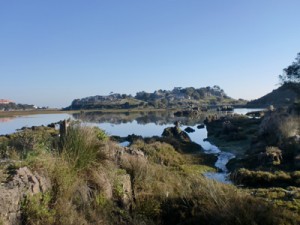The municipality of arnuero is located in Estern Cantabria. It is one of the most important tourist destinations in the region. This municipality has been awarded with numerous awards for the creation of projects on the preservation and considaration of the cultural and natural patrimony. This is the case of the Trasmiera Ecopark role model for a sustainable tourism and territory management. Some of those awards are, the EDEN Award 2011 (European Destinations of Excellenece) and the Hispania Nostra Award 2012. In addition we can say that Arnuero is dose not only comply with the minimum accessibility demands but it exceeds them, becoming an example to follow within the region.
A bit of History
The first written references about Arnuero are found in the Cartulario de Santa María de Puerto de Santoña. In early Modern Ages Arnuero formed, together with Ajo, Bareyo, Güemes, Meruelo and Noja, the Junta de las Siete Villas, integrated in the Merindad of Trasmiera. It is a documented administrative district from the IX century, to protect their common interests.
From the late S. XVI century till the S. XVIII century some of the greatest stonemason were formed, a tradition at the time and a relevant activity for the economical structure of the area. The Trasmiera area was also very productive in artists such as altarpiece makers, campaneros (bell makers) and carpenters.
Land of illustrious characters that have left a mark in our History:
– Alejandro de Gargollo, who cast the biggest church bell of Spain, situated in the Toledo Cathedral.
– Juan de Castillo, the architect master, known for the making of the Monasterio de los Jerónimos in Lisboa and four other buildings declared Heritage of Humanity.
– Gerardo de Alvear, costumbrist painter form the early XX century.
– Salvador Hedilla, famous planes pilot.
– Bruno Alonso, an important trade union member and a politian during the Second Republic.
– D. Juan Fernández de Isla, whom empowered the navy construction for the shipyard of Guarnizo, and as a prize, in this and other shipyards all over Spain, the King granted him the title of Count of Isla.





